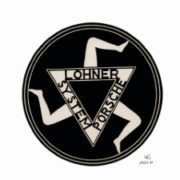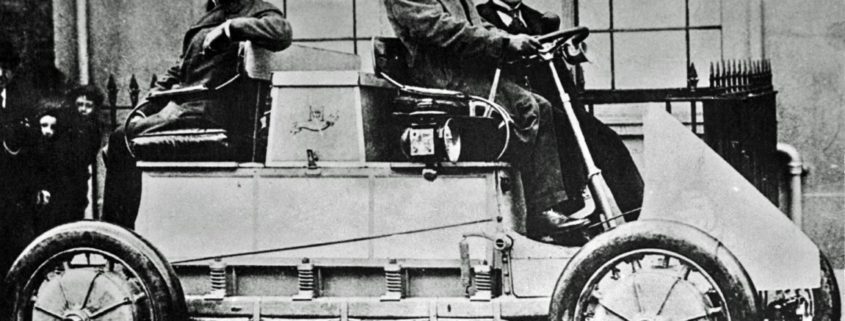The world´s first four-wheel drive car was a Porsche

Logo System Lohner Porsche
The Lohner-Porsche, a vehicle that was far ahead of its time … just as its inventor Ferdinand Porsche. As early as 1897, Porsche designed a wheel hub motor for the purveyor to the imperial household Jacob Lohner on behalf of the „Jacob Lohner & Co.” imperial coachbuilding works in Vienna. Two years later, the young engineer astounded the automotive world at the World’s Fair in Paris with his „System Lohner-Porsche” electro-automobile. It was built mostly of wood and was powered by hub motors on the front wheels. The built-in internal pole electric motors in the hubs delivered an output of around 3 hp each (briefly 7 hp). Its operating time was about three hours (44-cell lead-acid battery with 80 volt voltage); the maximum speed of the 980 kg car lay between 45 and 58 km/h.
Porsche’s creative urge reached its first peak around 1900. In a few months he anticipated the development of automobiles in the next 120 years: first with the development of an electric car, then a hybrid car. This evolution culminated in the further development of the electric vehicle into the „Lohner-Porsche race car” – the world’s first vehicle that was also powered by all four wheels. All-wheel drive was born!
The four-wheel drive electric race car was designed specifically for a British customer named E.W. Hart. (In the article picture Ferdinand Porsche is sitting next to the customer E.W. Hart). Ferdinand Porsche called the car „La Toujours Contente” (the always content) – in reference to two electric vehicles from other manufacturers, the „La Jamais Contente” (the never content) and the „La Presque Contente” (the almost content). The vehicle featured four 1500W hub motors. Since the batteries of the day could not store much energy, the weight of the batteries increased from 410 to 1800 kg. The race car looked like „a battery box on wheels”. It is notable that the battery container was suspended by coil springs, so that the sensitive battery cells were protected from road shocks.
Ferdinand Porsche was known for testing his designs himself, even in races. He entered a race with the Lohner-Porsche racing car in Chislehurst, England in 1900.
Porsche’s design principle of the four-wheel drive car was used on the moon 70 years later in NASA´s lunar car.
The Lohner-Porsche Mixte (1901) is on display in the Ferdinand Porsche Erlebniswelten fahr(T)raum in Mattsee.
Quellen
Ludvigsen, Karl (2010): Genesis eines Genies
Ferdinand Porsche Der Erfindergeist
Lohner Porsche, Fahrzeuge die Ihrer Zeit weit vorraus waren
Jelinek, Gerhard (2015): Sternstunden Österreichs. Die helle Seite unserer Geschichte. Der erste Porsche fährt elektrisch
Lohner Porsche erstes hybridauto erstmals Allrad-Antrieb
Bilder, https://commons.wikimedia.org/wiki/File:Lohner_Porsche.jpg







Ferdinand Porsche at Daimler (Mercedes)-Benz
/w Bez kategorii, Geschichte, Lebensstationen, Rennautos1926 Mercedes 24/100/140 PS on display in fahr(T)raum Ferdinand Porsche left Austro Daimler in 1923 due to differences with the Supervisory Board. As of April 30, 1923, he succeeded Paul Daimler on the Board of Management and as Chief Designer at the Daimler-Motoren-Gesellschaft (DMG) in Stuttgart. At Daimler he was in charge of the further […]
Original 1949 Porsche Konstruktionen GesmbH (Gmünd) water turbine now in fahr(T)raum
/w Bez kategorii, Geschichte, Lebensstationen, MotorenIn the years between 1944 and 1950, the Porsche works in Gmünd/Carinthia, which operated under the name Porsche-Konstruktionen-Ges.m.b.H., produced not only the Porsche 356 No. 1 Roadster but also designs for racing cars, tractors, cable winches, ski lifts and crossflow turbines. The Type 291 crossflow turbine – on loan from the Porsche Automuseum in Gmünd […]
Replica Hansa Brandenburg C1 from 1917 – Porsche’s grandson takes off
/w Bez kategorii, Flugzeuge, Lebensstationen, MotorenAfter discovering and acquiring an old six-cylinder Austro-Daimler series aircraft engine, Ing. Ernst Piëch, Ferdinand Porsche’s grandson and owner of the fahr(T)raum in Mattsee, has realised a dream – a replica of the twin-strut Hansa Brandenburg C1 biplane. The C1 replica corresponds to a variant series of 40 planes manufactured at the Phönix aircraft plants […]